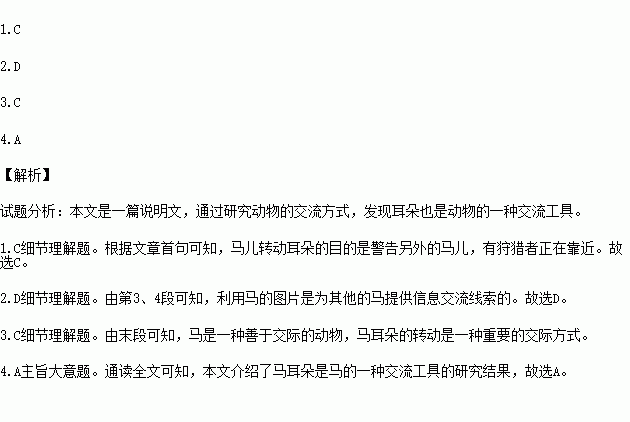题目内容
阅读下列短文,从每题所给的四个选项(A、B、C和D)中,选出最佳选项。
Very mobile ears help many animals direct their attention to the rustle of a possible attacker. Researchers say these mobile ears have become a useful communication tool. Their studies of animal behaviour build up a picture of how communication and social skills developed.
“We're interested in how they communicate,” said lead researcher Jennifer Wathan.“And being sensitive to what another individual is thinking is a fundamental skill from which other more complex skills develop.”
Ms Wathan and her colleague Prof Karen McComb set up a behavioural experiment where 72 individual horses had to use visual clues from another horse in order to choose where to feed. They led each horse to a point where it had to select one of two buckets. On a wall behind this decision-making spot was a life-sized photograph of a horse's head facing either to left or right. In some of the trials, the horses’ ears or eyes were covered.
If the ears and eyes of the horse in the picture were visible, the horses being tested would choose the bucket towards which its gaze and its ears were directed. If the horse in the picture had either its eyes or its ears covered, the horse being tested would just choose a feed bucket at random.
Like many mammals that are hunted by predators(捕食者), horses can rotate(旋转)their ears through almost 180 degrees - but Ms Wathan said that in our "human-centric" view of the world, we had overlooked the importance of these very mobile ears in animal communication.
"It seems there's something in the visual clues----from both the eyes and the ears-----that are really important," she told BBC News. "Horses have quite rich social lives and relationships with other horses, so they're a good species to look at this in." And the more we look at communication across different species, the more we can consider what might have promoted the evolution of sophisticated communication and social skills."
1.Why does a horse rotate its ears?
A. To tell each other where they can go for the buckets.
B. To be curious about what the other horse is thinking.
C. To warn the other horse when an attacker is coming closer.
D. To express its hope to build up social relations with others.
2.Why did the researchers use the life-sized photograph of a horse in the experiment?
A. To help develop horses’ complex skills.
B. To lead other horses to feed themselves.
C. To make the horses in the experiment excited.
D. To provide clues for the horses in the experiment.
3.Why are ears and eyes important to horses?
A. They can find the feeding buckets more easily with ears and eyes.
B. With ears and eyes they can escape from dangers more easily.
C. With ears and eyes they can communicate with other horses.
D. Horses have quite rich social lives with ears and eyes.
4.What can be the best title of the passage?
A. Rotary Ears Serve as Communication Tools.
B. Horses Have More Social Skills than Other Species.
C. Experiments with Horses’ Ears.
D. Fundamental Skills of Horses.

